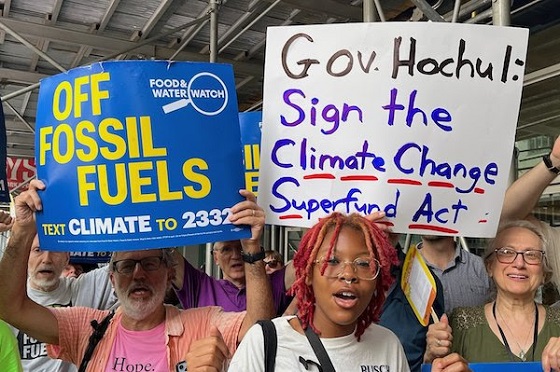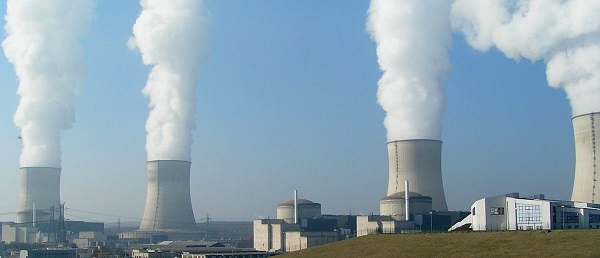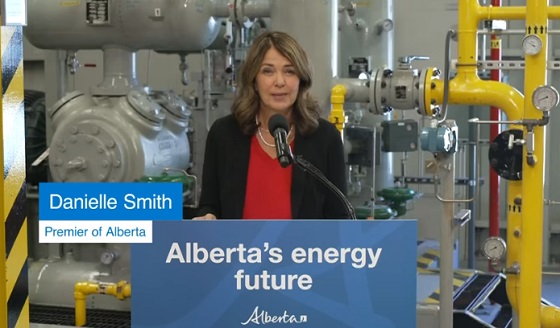Energy
DOJ urges federal judge to strike down climate change law

From The Center Square
By
The Trump administration is asking a federal judge to invalidate a New York law that seeks to punish fossil fuel companies for their alleged role in climate change.
In a motion for summary judgment, filed late Friday, the U.S. Department of Justice’s Environment and Natural Resources Division asked a U.S. District Court judge to “end New York’s lawless overreach” by “declaring the Superfund Act invalid and unenforceable, and permanently enjoining Defendants from taking any actions to implement or enforce it.”
“New York has declared war on those responsible for supplying our nation with reliable and affordable energy, and it is trampling over federal law in the process,” the filing states.
In May, the DOJ filed lawsuits against New York and Vermont, arguing that state laws requiring oil companies to contribute billions of dollars into funds to pay for damage caused by climate change were unconstitutional.
The legal challenge against New York alleges that the state’s “superfund” law is a “transparent monetary-extraction scheme” designed to fund the state’s infrastructure projects with money from out-of-state businesses.
“The Superfund Act is a brazen attempt to grab power from the federal government and force citizens of other States and nations to foot the bill for its infrastructure wish list,” the DOJ wrote in the 29-page complaint.
In both lawsuits, the Justice Department cited a Jan. 20 executive order signed by President Donald Trump declaring a national energy emergency to speed up permitting of energy projects, roll back environmental protections, and withdraw from an international pact to fight climate change. DOJ lawyers allege that the state climate change laws imperil domestic energy production.
New York’s Climate Leadership and Community Protection Act, signed by then-Gov. Andrew Cuomo in 2019, requires the state to reduce its excess greenhouse gas emissions and authorizes it to seek up to $75 billion in damages from fossil fuel companies. Regulations for the new law have yet to be issued, which prompted a lawsuit from green groups seeking the state to post them.
New York is also facing a lawsuit filed by 22 Republican attorneys general who argue that the law will do little to blunt the impact of climate change while passing on the costs to the state’s consumers in the form of higher energy bills. The outcome of that case is still pending.
Acting Assistant Attorney General Adam Gustafson said New York has “overstepped its authority in trying to impose crippling financial penalties on the world’s largest energy providers” and said the court must act to prevent further damage to the fossil fuel industry.
“Individual states have no authority to regulate nationwide and global greenhouse gas emissions,” he said in a statement. “The courts must put a stop to New York’s brazen disregard of federal law, the Constitution, and binding precedent, not to mention our Nation’s energy needs.”
Daily Caller
Trump’s ‘Massively Ambitious’ Nuclear Power Goals Might Save US From Rolling Blackouts


From the Daily Caller News Foundation
By Audrey Streb
While the Trump administration has been sounding the alarm over an imminent national energy crisis, it has also set aggressive nuclear expansion goals that industry insiders told the Daily Caller News Foundation may be achievable despite their ambitious scale.
The Trump administration has set a goal to quadruple nuclear power in the U.S. by 2050 and has moved to boost the energy technology through a smattering of executive actions. Though not every nuclear target outlined by the administration may be met, Trump has signaled that the U.S. could dramatically expand nuclear power in the coming years which is vital as blackouts loom and the artificial intelligence (AI) race accelerates, industry insiders told the DCNF.
“It’s going to be tough, but America has stepped up to plenty of major challenges like this in the past,” Benjamin Reinke, senior vice president of nuclear company X Energy and former executive director of the Office of Strategic Planning in the Department of Energy (DOE) under Trump’s first administration, told the DCNF. “Renewed focus on energy reliability certainly is a tailwind for the nuclear sector because of the attributes of advanced nuclear power. The opportunity to capture and win the global AI race with China is something that the U.S. has [to do].”
Dear Readers:
As a nonprofit, we are dependent on the generosity of our readers.
Please consider making a small donation of any amount here.
Thank you!
President Donald Trump signed four May 23 executive orders to clear hurdles for nuclear energy and set ambitious goals to expand the industry. Several nuclear energy sector insiders that spoke with the DCNF are gambling that America will be able to accomplish several of the goals outlined by the Trump administration, even if they are hesitant to believe that power generated from nuclear power could quadruple as soon as 2050.
Several energy insiders warned that it is vital to expand nuclear power now as it is a highly reliable energy resource, and widespread rolling blackouts are being forecasted by several analyses including one July report by the DOE that states blackouts could increase by a factor of 100 by 2030. Power demand is surging for the first time in decades and electricity consumption is projected to surpass the all-time 2024 high, according to the Energy Information Administration (EIA).
As the sector continues to boom, the industry will bring new jobs, technological innovations and power-hungry data centers. Nuclear advocates argue that the energy resource is well equipped to do the heavy lifting for the U.S. power grid.
Nuclear power plant generation has been declining in the U.S. since the 1990s and America has only managed to build two large nuclear reactors in the last 20 years. The newest reactors came online in Georgia nearly two decades after the projects began, running billions over budget and years behind schedule.
Big Tech is looking to nuclear as an attractive option to power its data centers and has considered adding small modular reactors (SMRs) as well as reviving shuddered nuclear plants to solve their power problems. Several states are seeing a revival in nuclear technology, with Microsoft making a deal to resurrect Three Mile Island in Pennsylvania and New York moving to open a new reactor after shuddering one just a few years ago. Additionally, the Michigan Palisades plant scheduled to reopen in October will mark the first defunct nuclear plant to return from the dead.
“Unlocking nuclear energy will be critical for meeting growing demand for affordable, reliable baseload power needed to fuel the AI race – our next Manhattan Project – while powering Americans’ homes and businesses,” a DOE spokesperson told the DCNF. “Thanks to President Trump’s
Reinke noted that Trump’s policies during his first administration started to breathe life into the nuclear sector, and former President Joe Biden also moved to forward nuclear technology through signing the ADVANCE Act. However, Biden’s energy policy focus centered around pushing for wind and solar projects, which some energy experts, grid operators and grid watchdogs have argued primed America’s power grid for outages.
“Energy security is national security,” Reinke said, echoing the phrase that Trump’s DOE repeated during the president’s first administration and is yet again a common slogan among cabinet members in the energy space.
“Folks are going to be without power,” Chief Development Officer of the Nuclear Company Juliann Edwards told the DCNF, referencing DOE’s July report. “By 2030 we’re going to start to see massive deficits in various parts of the United States. … The role nuclear plays is [that] it balances that baseload energy, so you have less volatility on the lines.”
The Nuclear Company is partnering with Palantir to boost nuclear development and is looking to develop its first fleet of reactor sites by the mid 2030s. Edwards noted that the Trump administration opening up federal lands for nuclear development “was huge because it opens up a lot of opportunities that didn’t exist before.”
DOE announced its initial selections for a nuclear reactor pilot program in line with one of Trump’s executive orders aimed at advancing 11 projects on Aug. 12. Among the selections was the nuclear company that designs and deploys reactors known as Oklo, the only selection chosen for more than one nuclear project.
Communications manager at Oklo, Paul Day, told the DCNF that Trump’s nuclear goals are “massively ambitious,” though they mirror America’s power needs.
“But I think it’s almost like a manifestation — we need this power. How are we going to get it? If we put our heads to the grind, we can actually get nuclear to do this,” Day told the DCNF. “Whether we can quadruple nuclear capacity by 2050, well, that remains to be seen. But there is an enormous amount of dead wood being cleared out here for the nuclear industry, and I think that will take us … in the right direction.”
Head of communications at Oklo Bonita Chester emphasized that the Trump administration has translated its nuclear ambitions into actionable steps that look promising to those in the industry. The Trump administration wants to have three reactors go critical by July 4, 2026, which is “highly ambitious, but what I’ve appreciated about this administration is they have been able to back a lot of these really quite dramatic plans with actual actions,” Chester said.
Chester added that fuel remains to be a huge hurdle for the nuclear industry. Advanced reactors need particular kinds of fuel, and Chester listed enriched uranium, recycled nuclear fuel waste and plutonium as viable options. Currently, the U.S. cannot supply enough fuel to power the influx of nuclear reactors, Chester added.
During his presidency, Biden designated nearly 1 million acres in Arizona outside the Grand Canyon as a monument, which shut down potential uranium development in the resource-rich area. The U.S. is a net importer of uranium and has been since 1992, according to EIA data. Canada and Kazakhstan are the biggest uranium suppliers to the U.S., according to EIA.
One of Trump’s executive orders included calling for the conversion of surplus plutonium to allow the private sector to use it, which has “never been considered before, and it’s incredible,” Chester said.
Changes at the Nuclear Regulatory Commission (NRC) are also a good sign for the sector, as Trump limited the wait time for permits to 18 months.
“We’ve never seen the NRC being so vocal about this stuff,” Chester said, noting that the NRC has been very public about reviewing projects ahead of schedule. Energy policy experts previously explained to the DCNF that permitting delays presented a major obstacle for the nuclear industry.
Notably, Chester told the DCNF that fast reactors have been commercialized in China and Russia, yet not in the U.S. where they were invented.
“We would be failing if we were just trying to turn on one reactor,” Chester said. “The goal is to commercialize our technology.”
Energy
Guess there’s a “business case” after all. Europe wants LNG, but can Canada still provide it?

From Resource Works
Canada misjudged the future of LNG, but we should still strive to salvage our current situation.
Mark Carney hasn’t been in office long, but his pivot on liquefied natural gas (LNG) may be one of his defining decisions. For years Ottawa said there was “no businesshttps://www.aljazeera.com/economy/2022/8/22/canada-would-need-business-case-for-lng-exports-to-europe-pmcase” for Canadian LNG, a phrase first uttered by Justin Trudeau in 2022 when Germany’s Olaf Scholz came knocking for alternatives to Russian gas.
That hesitation left Canada sitting idle while allies signed long-term contracts with Qatar, the United States, and Australia. Now, after years of missed opportunities, Carney is betting LNG can be both an economic strength and a foreign policy tool.
The question is whether Canada can move fast enough.
Europe’s appetite for LNG is not hypothetical. Germany has built four terminals since Russia’s invasion of Ukraine, with the latest opening in Wilhelmshaven in May.
Europe’s LNG imports reached near-record highs this past winter, pulling cargoes away from Asia where demand softened. In January alone, Europe imported nearly 12 million tonnes, while United States cargoes hit record levels.
Half of Europe’s LNG comes from the Gulf Coast. That infrastructure advantage, billions of dollars worth of liquefaction plants, pipelines, and tankers, is something Canada does not have.
Canada has only just begun. LNG Canada in Kitimat shipped its first cargo in July, a milestone nearly a decade in the making.
Six projects are on the drawing board. If all are built, Canadian capacity would hit 50 million tonnes a year, still half the United States total but enough to matter in a global market where even small shifts in supply mean billions of dollars and hard power gains.
Carney’s government is framing this as a nation-building moment. His Building Canada Act (Bill C-5) gives cabinet the ability to fast-track major projects deemed in the national interest.
In Europe last week, he teased upcoming announcements, hinting port expansions in Montreal, the East Coast, and Churchill, Manitoba could be among the first out the gate.
Churchill, Canada’s only deepwater Arctic port connected by rail, has long been written off as a grain terminal with a short summer season. But Indigenous-led Arctic Gateway has been expanding its capacity, with the first critical minerals shipped last year and new talks underway to evaluate year-round operations.
Turning Churchill into an LNG port would be no small task. Icebreakers, new jetties, and upgraded pipelines would be required. But Carney calls it “essentially a new port” that could unlock LNG and critical minerals exports to Europe.
Manitoba Premier Wab Kinew has signed on as a way to connect prairie energy and resources to the world, and Fednav, one of the few shipping firms with Arctic ice experience, has signed on to explore year-round access.
Skeptics point to the obstacles. Shipping windows in Hudson Bay are limited, and investors remember the 670 billion dollars in cancelled resource projects since 2015.
Spain’s Repsol abandoned its Saint John LNG conversion plan in 2023 citing costs. Critics argue if Canada could not make East Coast LNG work, then why would Churchill?
Carney’s answer is demand. Germany under Chancellor Friedrich Merz has taken a pragmatic line: it needs gas and lots of it, even as it invests in renewables and hydrogen. Brussels has committed to reducing Russian imports, but that gap must be filled from somewhere.
That is where British Columbia comes in. The west coast projects once seen as solely Asian-bound are now strategic for Europe too.
The Panama Canal provides a shorter shipping lane to Atlantic ports, and Canadian LNG is marketed as having the lowest carbon footprint in the world, a selling point in a Europe still tied to its climate goals.
Energy Minister Tim Hodgson says “there are buyers” and describes LNG as a cornerstone of Canada’s ambition to be an “energy superpower.”
Canada’s misjudgment of LNG was costly. Had exports been flowing between 2020 and 2022, analysts say Canadian gas could have displaced an entire year’s worth of Canada’s emissions by replacing coal abroad.
Instead, Asian and European utilities leaned on dirtier fuels and allies turned elsewhere. The United States and Qatar seized the moment. Canada said no.
Now the calculus has changed. Trump’s trade war has made diversification urgent. European allies are asking again, and this time Carney is listening.
Infrastructure on both coasts, from Kitimat to Churchill, may finally put Canada into the LNG game it once sat out.
The opportunity is still there, but hesitation is no longer an option. For Canada LNG is not just about moving gas molecules. It is about sovereignty, power, and resilience.
It is about whether we can still do big projects. And it is about whether we will finally turn our natural resources into real clout.
-

 Fraser Institute1 day ago
Fraser Institute1 day agoB.C. Aboriginal agreements empower soft tyranny of legal incoherence
-

 Daily Caller1 day ago
Daily Caller1 day agoTrump’s ‘Massively Ambitious’ Nuclear Power Goals Might Save US From Rolling Blackouts
-

 International1 day ago
International1 day agoTrump to sign executive order requiring voter ID for all elections
-

 Alberta1 day ago
Alberta1 day agoSmith government should create stricter rules for Heritage Fund to ensure annual deposits
-

 Bruce Dowbiggin15 mins ago
Bruce Dowbiggin15 mins agoMitch Ado About Marner: Angry Toronto Fans Needed A Scapegoat






